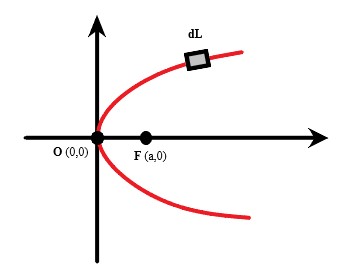CENTER
OF GRAVITY OF A PARABOLIC ARC
INTRODUCTION
The
center of gravity COG of an object is the point of action of the gravitational
force. It is also known as the balancing point since all objects [simple or
complex] have their COG within the object’s sphere of influence and this
ensures stability. There are two values to be noted which is the geometrical
center of gravity and the actual center of gravity. The geometrical COG is the
exact center of the object. It can be calculated by various available methods
like summation, moment of inertia, etc. The geometrical COG is valid as long as
there is uniform distribution of mass. In case of uneven mass distribution or
use of composite or heterogeneous materials, the actual COG will no longer
coincide with the geometrical COG. This is because mass is distributed unevenly
and the COG will shift where there is more mass. In this article we intend to
determine the COG of an arc of a regular parabola and we assume uniform mass
distribution for simplicity.
ASSUMPTIONS
1. Mass
of the object is evenly distributed
2. Earth has uniform
gravitational field
CALCULATION
Consider
a regular parabola. Let A≡ [h, k] be the
vertex of the parabola and B ≡ [h + a, k] be
its focus. Let ‘a’ be the distance between the focus and vertex. This is a
parabola which is along the x axis. For simplicity let us assume that the
vertex is the origin. Consider a small rectangular length element of width ‘dL’.
This element when integrated traces out the arc length of the Parabolic arc.
The equation of parabola or arc of a parabola is,
If
vertex is origin, replace (h, k) by (0, 0) in the above equation,
The
equation can be rearranged to represent in terms of y as,
 |
| Fig .1 Parabolic Arc |
To
determine the center of gravity, we need to follow three steps:
1 1. Determine the length of the element in terms of one
of the known variables x or y
2 2. Determine the arc length or the total length of the
circle by integrating the element dL
3 3. Determine the C.O.G coordinates (x, y) by integrating
each variable and dividing by the total length
Once
we have the above three values, we can determine the COG coordinates.
Step1: Length of the element dL
From
fig.1, we can observe that dL can be represented in terms of ‘dx’ and ‘dy’ by
using the Pythagorean Theorem.
On
taking dx common out of the square root, we obtain
Step2: Total length of the element
We
can solve the above equation by differentiating y with respect to x, which is
differentiating the equation of circle.
On
solving we obtain,
Integrate
the above equation indefinitely to obtain the total length of the curve.
This
is the arc length of a parabolic arc. When the lower and upper bounds of
integration are set, we will obtain the perimeter of parabola or arc of parabola
based on the choice of limits.
Step 3: COG of the object {parabolic arc}
We
now can perform integral calculations to determine the x and y coordinates respectively.
First
we integrate x and y with respect to x. Later divide each answer by ∫dL to determine the x and y coordinate of C.O.G
On
performing numerical computation, we obtain the values of integration as
follows:
The
x integral is,
The
y integral is,
The
C.O.G coordinates are,
CONCLUSION
We
thus determined the center of gravity of a Parabolic Arc.











No comments:
Post a Comment